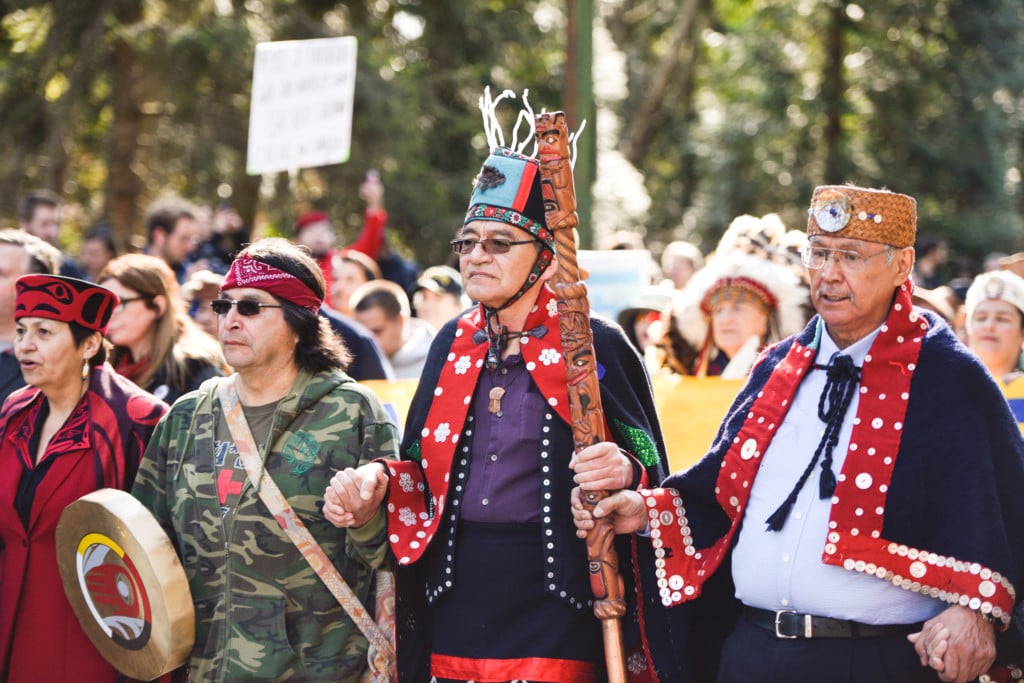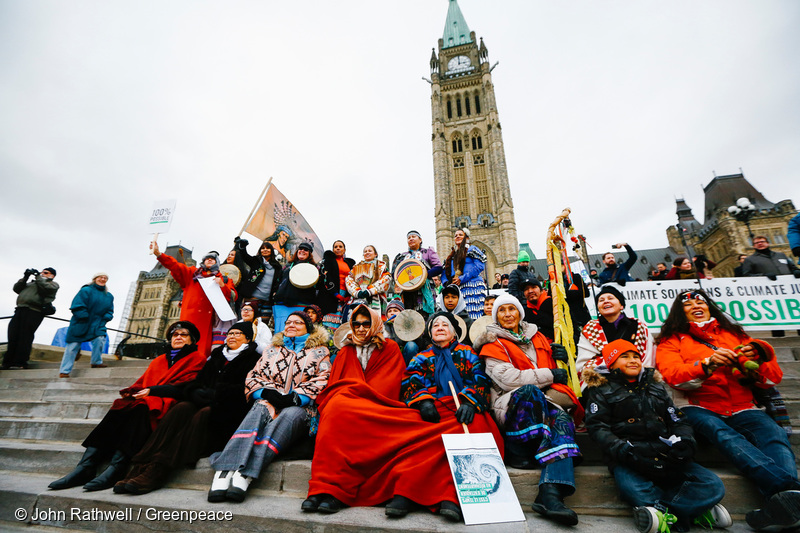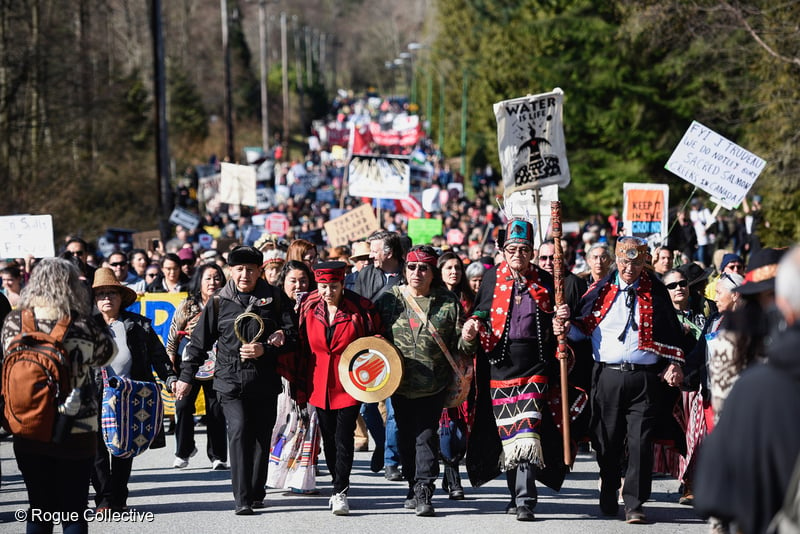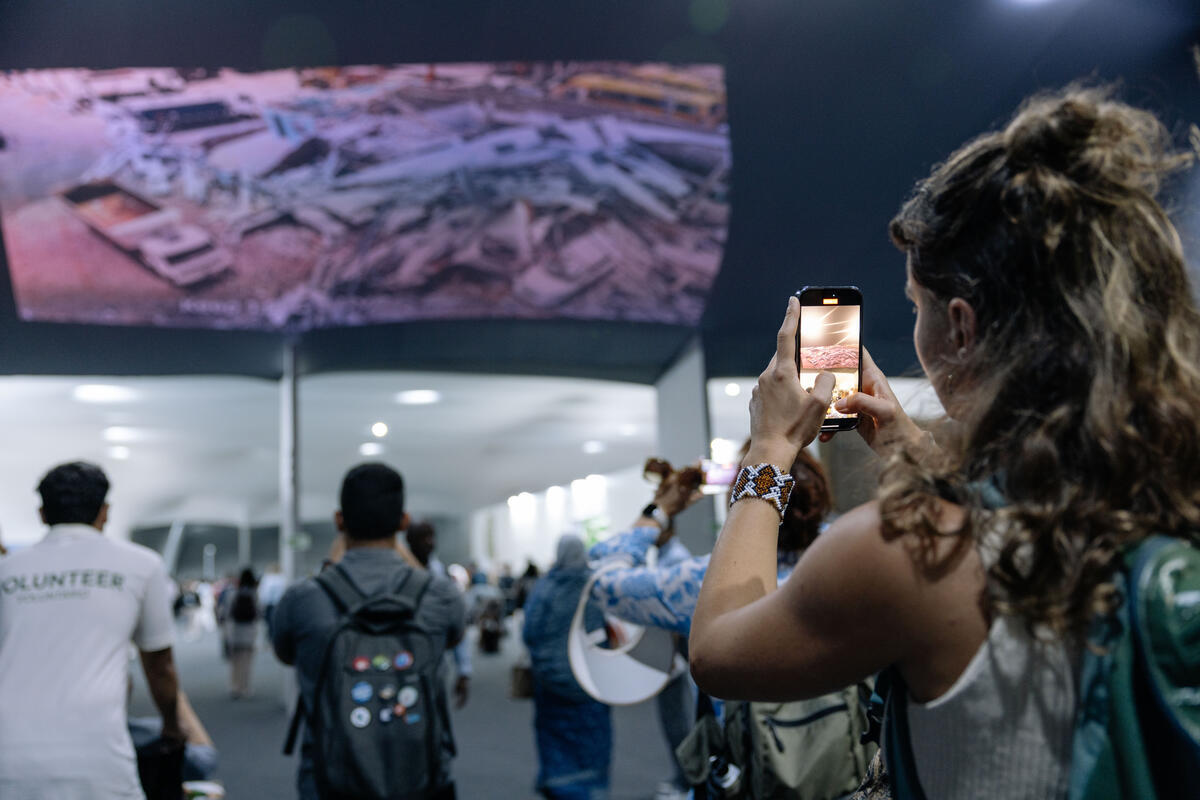4 July 2018 (UNCEDED COAST SALISH TERRITORIES/VANCOUVER) — The Greenpeace Canada aerial bridge blockade in the path of the Trans Mountain tar sands oil tanker, Serene Sea, has ended. The tanker was loaded with oil from the Alberta tar sands and waited at anchor while the blockade prevented it from leaving.
After spending more than 35 hours on the Ironworkers Memorial Bridge in Vancouver, the climbers who rappelled from the bridge and supporting blockade members were peacefully removed from their positions. The RCMP are taking the activists to the North Vancouver RCMP detachment. [1]
The two-day blockade was made up of twelve people hailing from the Indigenous Coast Salish community, B.C., Alberta, Quebec, Ontario, the U.S.A (Washington state), Mexico and the U.K.
Will George, an Indigenous Coast Salish member joined the blockade as a climber. He is also the spokesperson and leader of Kwekwecnewtxw. He said: “I will remain the fierce opposition. It is in my blood to protect the water. Our Indigenous rights are being completely ignored, the safety of our water is being ignored, and most of all my son’s future is at stake. I will do whatever it takes to protect the water and my family and your family.”
Mike Hudema, a Greenpeace Canada spokesperson and climber, said: “No one should need to spend almost two days suspended from a bridge trying to protect something as essential as water but that’s exactly what the Prime Minister Trudeau has driven us to do. The Prime Minister still has a chance to make the right decision and stop this pipeline. But whether it’s by his pen, in the courts, or the global resistance, the pipeline won’t be built — and this movement of people isn’t going anywhere.”
Opposition to Canadian Prime Minister Justin Trudeau’s plans to buy the existing and proposed Trans Mountain pipelines has been intense, given the $4.5 billion cost to taxpayers. The blockade followed months of escalating protest against TMX and other pipelines by Indigenous communities in B.C., down the Washington coast, and across Canada.[1] In recent months, more than 200 people have been arrested in B.C., while protests abroad have happened in the U.S., U.K., Switzerland, and Spain.
To support the resistance against TMX and other controversial pipelines, more than 280,000 Greenpeace supporters around the world have called on 12 major banks (“the Dirty Dozen”) to refrain from financing these pipelines. A number of banks have made commitments along these lines, including HSBC and BNP Paribas (Europe’s two largest banks).
If built, TMX would increase tar sands tanker traffic in Vancouver seven-fold to about 400 tankers each year. This could push the remaining 75 endangered Southern resident orcas to extinction and threaten coastal communities, as well as the coastal marine ecosystem, with devastating oil spills.
-30-
[1] Less than half of the 120 First Nations along the route signed agreements with Kinder Morgan (43 First Nations). Indigenous Coast Salish unceded territories include the B.C. coast at the end of the proposed pipeline, as well as the waters of the Salish Sea, through which tankers loaded with oil from TMX would pass. As TMX has not received consent or agreement from more than half of potentially impacted Indigenous communities, the project is in violation of the UN Declaration on the Rights of Indigenous Peoples. The Trudeau government officially supports the declaration.
Photos, video and b-roll: https://media.greenpeace.org/collection/27MZIFJWLMBUH
Contact:
Jesse Firempong, Communications Officer, 778-996-6549, [email protected]
Loujain Kurdi, Communications Officer: 514-577-6657, [email protected].

Pipelines are expensive to build and require billions of dollars in funding from banks. Some banks are already backing away from tar sands pipelines because they’re a risky investment that threaten the climate. However, through our internal investigations we’ve found 12 banks, nicknamed “The Dirty Dozen” , from all over the world that continue to financially support tar sands pipelines.
Take action



Discussion
Amazing creativity and bravery! Thankyou Greenpeace volunteers.
Although I share your concern with the TM Pipeline I suggest that a two pronged approach be used instead of only protesting the pipeline. Yes the protests should continue in order to show the valid concerns about this pipeline. But if the protests fail to stop the pipeline development then there should be a Plan 'B', which is to convince the federal government to take all necessary steps to prevent and minimize any spills and to provide effective cleanup provisions. The pipeline MUST be built with the best anti-spill technology and be supplemented with full containment facilities (like berms and catch basins) particularly near waterways. Even though spills are inevitable then should be addressed by measures that minimize the likelihood of this happening and ensure that the immediate and long-term impact of any spill is minimized. Similarly the risks of a tanker catastrophe MUST be minimized. One measure to consider is to ensure that each tanker is double-hulled and that all tankers be controlled by at least two powerful tugboats. The tugboats would not just accompany the tankers but be tethered to the tankers at all times when the tankers are in the Salish channels. Tankers would also not be permitted to sail in any conditions where visibility is less than 100 metres or sustained winds are in excess of 40 km per hour. (Those values are realistic suggestions but could be strengthened, based on marine research.) Other safety measures can be demanded so as to better address the concerns of a land or marine spills. I hope that this two-pronged approach will prove to be more acceptable to both sides of the TM pipeline debate.